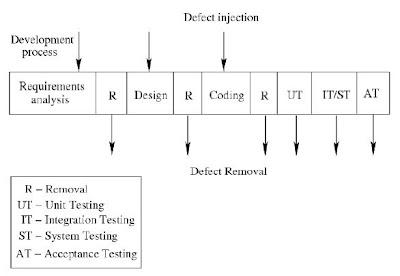Having set the goals for effort and schedule, the goal for the third key dimension of a project—quality—needs to be defined. However, unlike schedule and effort, quantified quality goal setting for a project and then planning to meet it is much harder. For effort and schedule goals, we can easily check if a detailed plan meets these goals (e.g., by seeing if the last task ends before the target date and if the sum total of effort of all tasks is less than the overall effort goal). For quality, even if we set the goal in terms of expected delivered defect density, it is not easy to plan for achieving this goal or for checking if a plan can meet these goals. Hence, often, quality goals are specified in terms of acceptance criteria— the delivered software should finally work for all the situations and test cases in the acceptance criteria. Further, there may even be an acceptance criterion on the number of defects that can be found during the acceptance testing. For example, no more than n defects are uncovered by acceptance testing.
The quality plan is the set of quality-related activities that a project plans to do to achieve the quality goal. To plan for quality, let us first understand the defect injection and removal cycle, as it is defects that determine the quality of the final delivered software.
Software development is a highly people-oriented activity and hence it is error-prone. In a software project, we start with no defects (there is no software to contain defects). Defects are injected into the software being built during the different phases in the project. That is, during the transformation from user needs to software to satisfy those needs, defects are injected in the transformation activities undertaken. These injection stages are primarily the requirements specification, the high-level design, the detailed design, and coding. To ensure that high-quality software is delivered, these defects are removed through the quality control (QC) activities. The QC activities for defect removal include requirements reviews, design reviews, code reviews, unit testing, integration testing, system testing, acceptance testing, etc. Figure 4.2 shows the process of defect injection and removal.
Figure 4.2: Defect injection and removal cycle
As the final goal is to deliver software with low defect density, ensuring quality revolves around two main themes: reduce the defects being injected, and increase the defects being removed. The first is often done through standards, methodologies, following of good processes, etc., which help reduce the chances of errors by the project personnel. (There are specific techniques for defect prevention also.) The quality plan therefore focuses mostly on planning suitable quality control tasks for removing defects.
Reviews and testing are two most common QC activities utilized in a project. Whereas reviews are structured, human-oriented processes, testing is the process of executing software (or parts of it) in an attempt to identify defects. The most common approach for quality planning in a project is to specify the QC activities to be performed in the project, and have suitable guidelines for performing each of the QC tasks, such that the chances of meeting the quality goals are high. During project execution, these activities are carried out in accordance with the defined procedures.
When this approach is used for ensuring quality, making quantitative claims can be quite hard. For quantitative assessment of the quality processes, metrics-based analysis is necessary. That, however, is an advanced topic, beyond the scope of this book (and indeed many organizations). Hence, for ensuring quality, the reliance is primarily on applying suitable QC techniques at the right places in the process, and using experience to ensure that sufficient QC tasks are done in the project.
Hence, the quality plan for the project is largely a specification of which QC task is to be done and when, and what process and guidelines are to be used for performing the QC task. The choice depends on the nature and goals and constraints of the project. Typically, the QC tasks will be schedulable tasks in the detailed schedule of the project. For example, it will specify what documents will be inspected, what parts of the code will be inspected, and what levels of testing will be performed. The plan can be considerably enhanced if some expectations of defect levels that are expected to be found for the different quality control tasks are also mentioned—these can then aid the monitoring of quality as the project proceeds.





Thanks for the post! For cleaning services software, you can visit http://www.optiqo.com/.
ReplyDeleteThanyou for your amazing article regarding Quality Planning. ICT Quality Assurance Engineer creates, maintains and manages technical quality assurance processes and procedures to assess efficiency, validity, value and functional performance of computer systems and environments, and audits systems to ensure compliance with, and adherence to, accredited internal and external industry quality standards and regulations. May supervise the work of ICT quality assurance teams. Refer Samples for ICT quality assurance
ReplyDeletenice article
ReplyDeleteIt is quite beneficial, although think about the facts when it reaches this target. Construction Management
ReplyDeleteMany thanks for this excellent information. Visit our website to get the best employee monitoring software
ReplyDeletebest garage management software
best employee location tracking system
Best SEO Services
Garage Management software